
Drone Review: JJRC X16 review
Summary
Score: 3.5
-
Price/performance ratio: 4.0
-
Design and build quality:3.8
-
Transmitter:3.7
-
Camera / WiFi FPV:2.8
-
Battery life:3.4
I started my JJRC X16 review with great expectations, but after I unbox it and found out that it does not feature onboard recording I become disappointed. Recording from WIFI FPV is the worst quality that you can get. Also, the camera does not have remote angle adjustment nor gimbal stabilization.
In terms of flight performance, the X16 Heron is quite stable and easy to control. GPS assisted RTH worked well and accurately. I liked the remote’s status screen, it provides all the flight info you need.
As a conclusion, the JJRC X16 is a nice entry-level drone for its price but can’t be considered as a true Mavic Mini alternative. It fails against DJI’s smallest foldable drone in all aspects: smart features, image quality, flight range, and battery life.
User Review
( votes)Pros
- Friendly priced with an included case;
- Under 200 grams, no FAA registration required;
- You can toggle between front and belly camera;
- Brushless motors instead of cheap brushed ones;
- Real-time color effects via APP;
- Low-battery voltage alarm on RC (slow/fast beeping);
- Silent operation;
Cons
- Pseudo 6K camera with no onboard recording;
- Poor image quality, affected by range, lots of wobbling;
- No gimbal stabilization, nor remote angle adjustment;
- Props with screws instead of quick-release ones;
- Poor flight range;
JJRC X16 Heron review
The JJRC X16 review will be my first cooperation with RCG and, to be honest, it was the first time I heard about them as well. Initially, they contacted me with the intention to sell me some RC products. Their product range includes Drones, FPV systems, RC parts, and RC cars.
In just 3 weeks from their first email, the package arrived at my door, with no customs declarations or additional fees. The JJRC X16 comes in a simple but handy storage bag with CNC cut foam padding. Besides the drone and its transmitter, there was included a flight battery, charging cable, one set of spare propellers (8-leaf), a screwdriver, and an instruction manual.
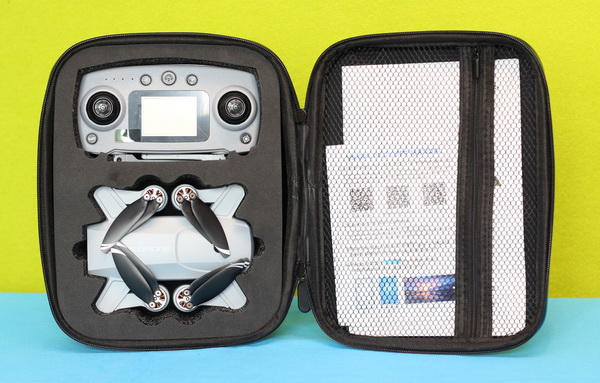
At a glance
The first thing I noticed was that the X16’s propulsion system (motors and propellers) is almost identical to the one of my Mavic MINI has. Instead, it features a different folding mechanism, IMHO a more simple and less possible to break the arms during folding in and out. Overall, the built quality is good but not exceptional like in the case of a DJI drone, there are even traces of glue remained on the aircraft.
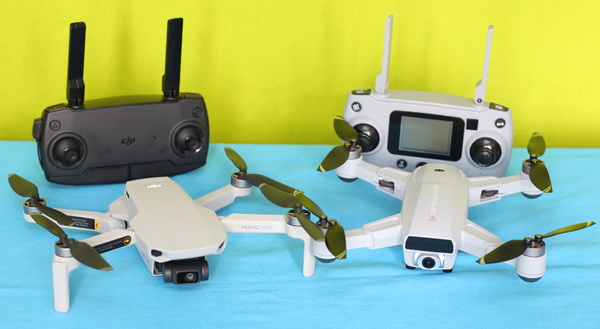
With folded arms, the aircraft measures about 16×10.5×6.2 cm and with extended arms, ready to fly, 27.5×27.8×6.2 cm. With loaded battery weighs 194 grams, so no FAA registration required (at least, at the moment). At bottom of the airframe, there are 8 landing pads (two on each corner) – to be honest, they look quite bulky and don’t provide too good stability.
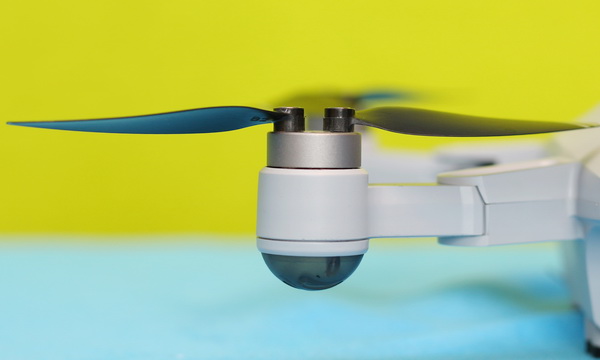
The power button is located on top of the drone and needs to be pressed a few seconds in order to start it. During night flights you are assisted by four LED lights, one under each motor (blue in front, red on back).
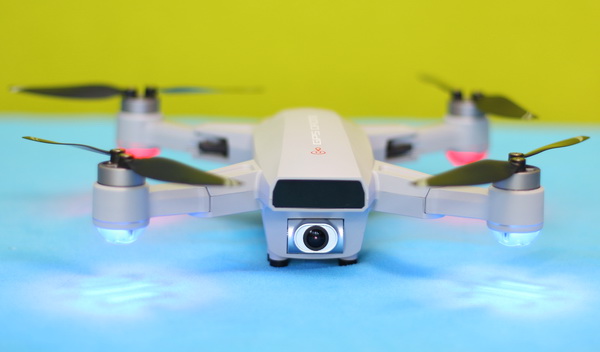
First user reviews complained that it doesn’t have a micro SD card slot (on-board recording), this is unfortunately true :(. Also, the camera’s tilt angle can be adjusted only manually.
On the belly, there is a second tiny camera that servers as an optical-flow sensor. A nice feature is that can be activated in life-view, allowing ground inspection.
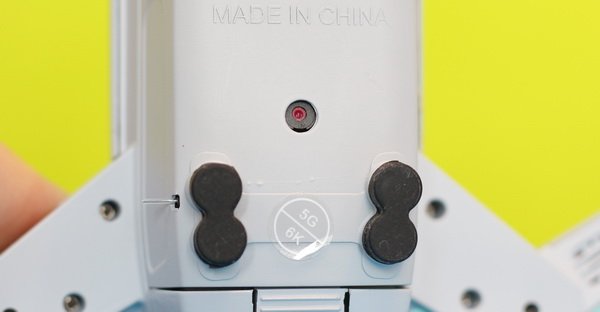
JJRC X16 review: Transmitter – Control range
JJRC packs the X16Heron with a nice entry-level remote controller that claims to provide up to 500 meters of control distance. On the front panel, besides the usual sticks, you have 5 buttons (Headless mode, RTH, Power On/Off, Take-off/Landing, and GPS/Height mode switch) and a detailed status LCD screen. From left to right there are the following real-time telemetry data provided: RC signal strength, Flight speed, Flight altitude, Distance from RC, RC battery level, Drone battery level, and the number of satellites.
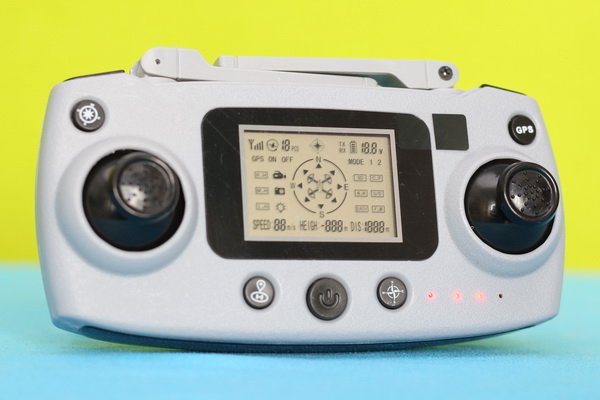
Despite that the display shows ‘Mode 1’ operation, the remote works in ‘Mode 2’ – Throttle on the left stick. I tried many button&stick combinations but didn’t find a way to change the working mode.

The Mavic Mini like foldable antennas are fake, with no real antenna inside of them. According to the specs, the range should be close to 500 meters. In an open field, with almost zero radio noise I managed to fly as far as 530 meters and, after this distance, the FPV signal became very choppy, and RC started to beep that its time to return.
JJRC X16 review: Battery life
The JJRC X16 Heron is powered by a 2 cell, 7.6V/1450mAh battery pack and it has an advertised of up to 25 minutes flying time. During my indoor tests, I got an average of 19 minutes of hovering time, so I expect around 15~20 minutes of real-world battery life.
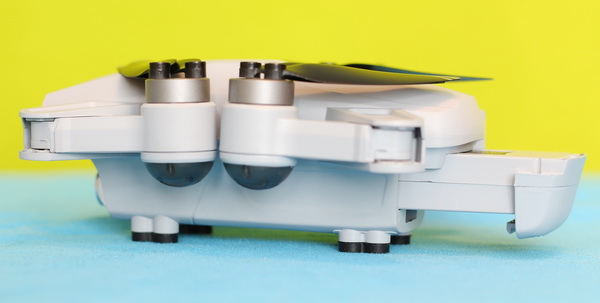
Charging the battery can be done from any phone charger using the included micro USB cable. The battery has two charging indicator LEDs (green and orange). As charging time takes almost two hours, it is recommended to purchase at least one spare LIPO pack.
JJRC X16 review: VS GPS Pro mobile APP
In order to explore all the potentials of the JJRC X16 drone, you need to download and install the VS GPS Pro APP on your mobile device. Besides some basic settings, accessing smart flight modes, and FPV view, the APP allows you to take still photos and to record videos. The footage is stored in the phone’s memory.

The APP has a friendly, easy to use interface. While on the bottom ribbon are shown flight height, distance, vertical and horizontal speeds, on the top one, the number of satellites found, RC signal strength, drone, and RC battery level.
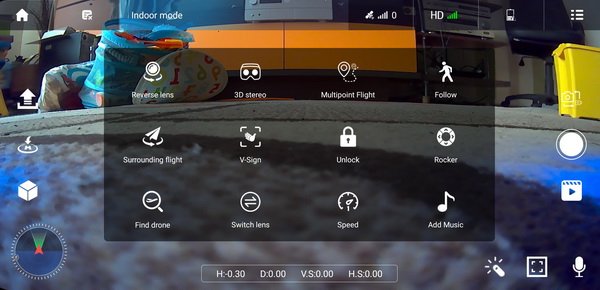
Under the settings menu, you can enable/disable ‘Novice mode’, set max flight distance (20~300 meters), max flight height (10~120 meters), and around radius (5~50 meters). From here you can access Horizontal and Compass calibrations.
From the ‘Smart modes’ screen (cube shape icon) you can reverse lens orientation and toggle between front and belly camera. Here you can access Follow me, Surrounding, and Multipoint autonomous flight modes. Also here, you can access the ‘Find drone’ function which shows on a map the last known GPS position of your drone.
JJRC X16 review: Flight experience
Prior to your flight, you need to perform gyro-calibration. The APP will provide you a detailed step-by-step guide on how to perform it. In a nutshell, firstly you need to take it up and rotate it clockwise horizontally, then repeat the step again but this time with the nouse of the drone facing the sky (in vertical position).
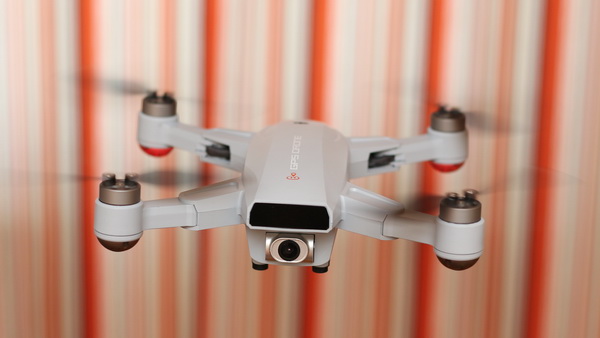
For now, I did only a few demo flights inside my room. The X16 Heron feels easy to control and quite stable, but its hovering performance is not even close to the one the Mavic Mini has. It constantly loses/gains altitude. There is also some horizontal movement from where you left it initially in hovering position.

This section will be updated in the following days with more JJRC X16 flight impressions. I’m planning to test the max flight altitude and the best flight range that you can get.
Price, availability, and options
Now, you can order this entry-level GPS drone with 28% off for $107.99 – this price includes the storage bag shown in my review. At the checkout, you can also opt for 1 or 2 additional batteries. For the ‘Fly More Combo’ pack (3 batteries) you will need to pay 20 extra bucks. You can also opt for a black or white edition. Personally, I prefer light colors for my drones because they are heating up less in the sun. Using this ‘664QDTH7AJNX‘ coupon code you can save 3%!
JJRC X16 review: Camera performance
While most of the JJR/C X16 promo banners advertise an exciting ‘true 6K camera’, unfortunately, the reality is quite disappointing. It does not even have an on-board recording, all the videos are captured from the FPV footage. Recording quality is widely dependent on the WIFI signal and degraded by distance. Camera angle adjustment is possible, but only manually before take-off.
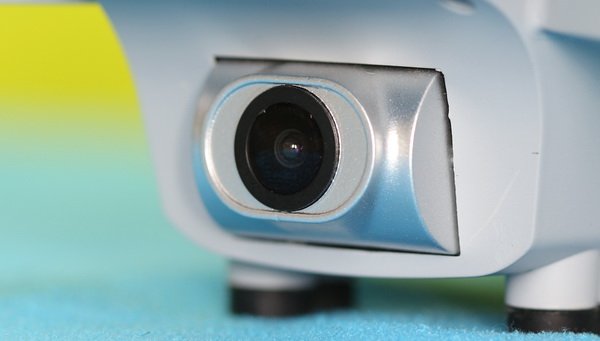
Photo size, video resolution nor frame rates can be adjusted, it is a total noob camera. The picture size is 6144 x 3456 pixels, but based on the quality, I think the 6K resolution is obtained by software interpolation.
Additionally to the frontal camera, you have the optical-flow sensor at the bottom, which can be used as a standard camera as well – you can even record from its point of view.